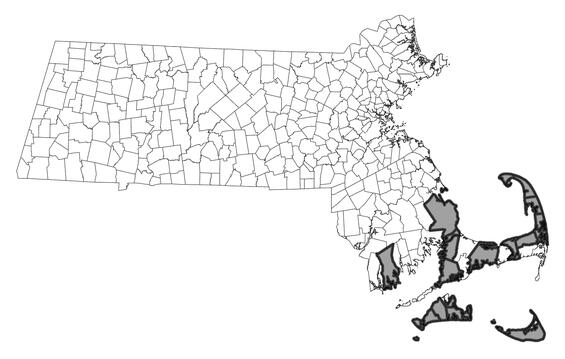- Scientific name: Crocanthemum dumosum E.P.Bicknell
- Species of Greatest Conservation Need (MA State Wildlife Action Plan)
Description
Bushy rockrose is a globally rare, bright yellow perennial wildflower of coastal herbaceous grasslands and heathlands. This species is bushy, with stiff stems and many divergent, reddish branches. The buttery-yellow, five-lobed flowers bloom in full sun and are short-lived, casting their petals by the next day. Deep green vegetation appears dusky due to pubescence on the stems, leaves, and sepals. Leaves are darker above and pale below.
Bushy rockrose can grow to 25 cm (~10 in) and appears sprawling. Leaves are elliptical and small (8–15 mm [0.31-0.59 in]), alternate, and often crowded on the branchlets. The leaves are covered in an intermixed dense pubescence of stellate hairs and longer simple hairs (up to 1 mm [0.04 in]); the pedicels and sepals may also have reddish glandular hairs. Bushy rockrose produces two kinds of flowers; the early open (i.e., chasmogamous) flowers have showy petals and are insect-pollinated, whereas the later, closed flowers (i.e., cleistogamous) lack petals and are self-pollinated. The earlier, open flowers are approximately 2.5 cm (~1 in) and are born singly (rarely paired) at the tip of the stem and main branches. Prior to flowering, the buds appear reddish. The later, closed flowers are solitary occurring at the branch tips or the forks of leafy branchlets. Seeds are nearly as long as they are thick and are produced in capsules.
This species is notoriously difficult to distinguish from the more common frostweed (C. canadense) because it shares many characteristics. These species must be carefully examined to differentiate them. Phenologically, they differ in that bushy rockrose produces open flowers earlier in the season than frostweed.
Morphologically, the more common species is overall more upright with fewer branches and has less dense leaf pubescence on the upper surface than the rare species. See the key differentiating characters in the table below. Low frostweed (C. propinquum) and Bicknell’s frostweed (C. bicknellii) differ from both of the above species in that they produce a greater number of open flowers in corymbs (not singly), lack glandular hairs on the sepals and petioles, and lack simple hairs on the upper leaf surfaces.
Life cycle and behavior
The buttery-yellow, five-lobed flowers bloom in full sun and are short-lived, casting their petals by the next day.
Population status
Bushy rockrose is a species of greatest conservation need and is maintained on the plant watch list. It is currently known from Nantucket, Barnstable, Dukes, and Bristol counties and is historically known from Plymouth County.
Distribution and abundance
Bushy rockrose is endemic to the coastal plain of the northeastern United States. This species is currently critically imperiled in Rhode Island, imperiled in New York, vulnerable in Massachusetts, and possibly extirpated in Connecticut. It is not known from any other locations. Massachusetts has the majority of the world's population of bushy rockrose.

Distribution in Massachusetts
1999-2024
Based on records in the Natural Heritage Database
Habitat
In Massachusetts, all occurrences are associated with the coastal plain. Bushy rockrose inhabits open sandy soils of coastal sandplains and heathlands. It is sometimes found along the frequently mowed edges of golf courses along the coast. This species prefers dry, sandy, acidic soils and open sun. Associated species of these habitats include little bluestem grass (Schizachyrium scoparium), sandplain blue-eyed grass (Sisyrinchium fuscatum [special concern]), New England blazing star (Liatris scariosa var. novae-angliae [special concern]), scrub oak (Quercus ilicifolia), black huckleberry (Gaylussacia baccata), seaside goldenrod (Solidago sempervirens), bushy aster (Symphyotrichum dumosum), beach pinweed (Lechea maritima), bearberry (Arctostaphylos uva-ursi), and low bush blueberry (Vaccinium angustifolium).
Healthy habitats are vital for supporting native wildlife and plants. Explore habitats and learn about conservation and restoration in Massachusetts.
Threats
Bushy rockrose thrives in early succession habitats and is frequently found in areas of mild disturbance. Threats to this species include habitat loss due to development and fire exclusion, which can lead to competition from invasive and aggressive native species.
Conservation
Some research has shown that reproduction follows periods of disturbance. Fire has been shown to encourage regeneration and to enhance adult growth of this species. Burning, mowing, or soil scarification are recommended to retard succession and competition. The removal of windbreaks has also been shown to improve bushy rockrose habitat.
References
Daoud, H.S. and R.L. Wilbur. 1965. A revision of the North American species of Helianthemum (Cistaceae). Rhodora 67: 63–312.
Dunwiddie, P.W. 1990. Rare plants in coastal heathlands: observations on Corema conradii (Empetraceae) and Helianthemum dumosum (Cistaceae). Rhodora 92: 22–26.
Fernald, M.L. 1917. Helianthemum dumosum on the mainland of New England. Rhodora 19: 58–60.
Haines, A. 2011. Flora Novae Angliae – a Manual for the Identification of Native and Naturalized Higher Vascular Plants of New England. New England Wildflower Society, Yale Univ. Press, New Haven, CT.
NatureServe. 2025. NatureServe Network Biodiversity Location Data accessed through NatureServe Explorer [web application]. NatureServe, Arlington, Virginia. Available https://explorer.natureserve.org/. Accessed: 5/23/2025.
Contact
| Date published: | April 14, 2025 |
|---|